load capacity OLDSMOBILE SILHOUETTE 1993 Owners Manual
[x] Cancel search | Manufacturer: OLDSMOBILE, Model Year: 1993, Model line: SILHOUETTE, Model: OLDSMOBILE SILHOUETTE 1993Pages: 323, PDF Size: 17.13 MB
Page 99 of 323
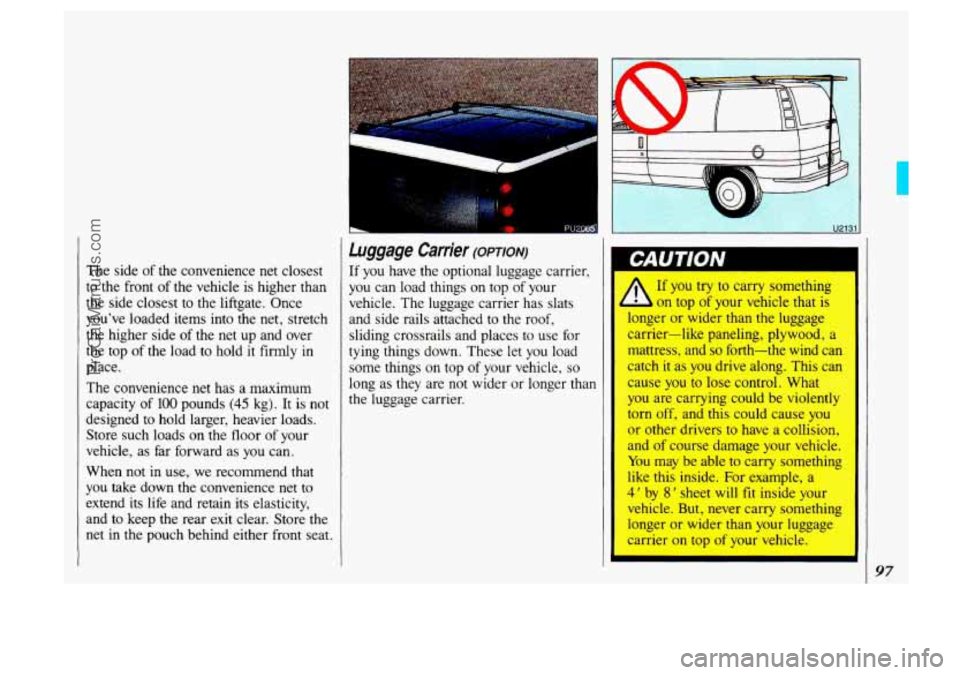
The side of the convenience net closest
to the front of the vehicle is higher than
the side closest to the liftgate. Once
you've loaded items into the net, stretch
the higher side of the net up and over
the top of the load
to hold it firmly in
place.
The convenience net has a maximum
capacity of
100 pounds (45 kg). It is not
designed to hold larger, heavier loads.
Store such loads on
the floor of your
vehicle, as far forward as you can.
When not
in use, we recommend that
you take down the convenience
net to
extend its life and retain its elasticity,
and to keep the rear exit clear. Store
the
net in the pouch behind either front seat.
L
-+
Luggage Carrier (OPTION)
If you have the optional luggage carrier,
you can load things on top of your
vehicle. The luggage carrier has slats
and side rails attached to the roof,
sliding crossrails and places to use for
tying things down. These let you load
some things on top of your vehicle, so
long as they are not wider or longer than
the luggage carrier. If you
try to
carry something
on top of your vehicle that is
longer or wider than the luggage
I
carrier-like paneling, plywood, L
mattress, and so forth-the wind can
itch
it as you drive along. This ca
;e you to lose control. Wha
you are carrying could be violent1
torn off, and this could cause you
or other drivers to have a collision.
and of course damage your vehicle.
You may be able to carry something
like this inside. For example, a
4' by 8' sheet will fit inside your
vehicle.
But, never carry something
longer or wider than your luggage
carrier on top
of your vehicle.
I
97
ProCarManuals.com
Page 100 of 323
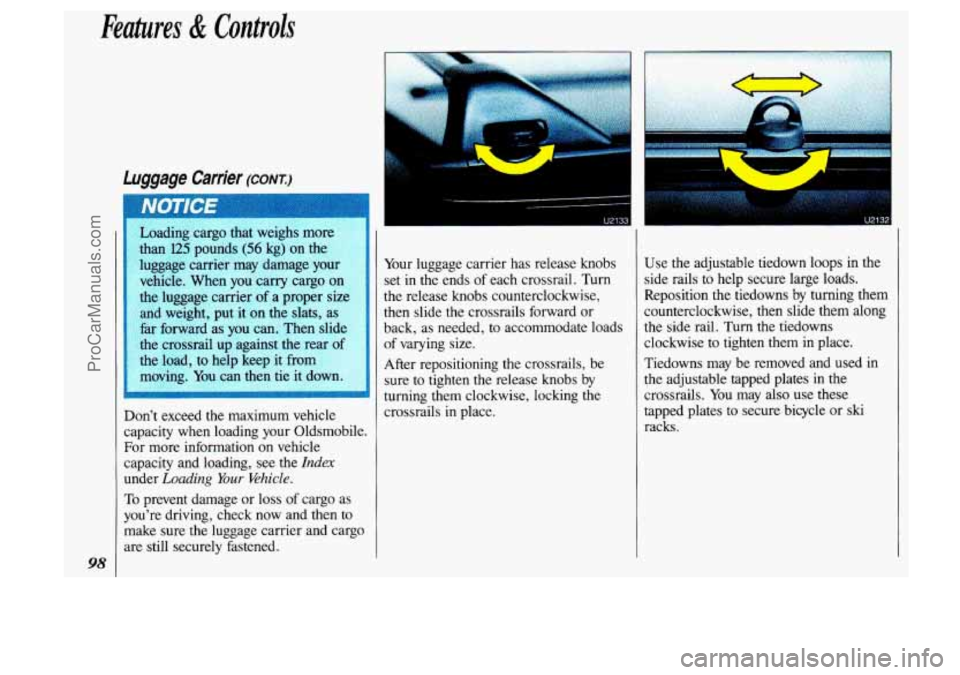
Features & Controls
98
luggage Carrier (CONT.)
luggage carrier may damage your
vehicle. When
you carry cargo on
the luggage carrier
of a proper size
and weight, put
it on the slats, as
far forward as you can. Then slide
the crossrail up against the rear of
the load, to help keep it from
moving. You can then tie it down.
Don't exceed the maximum vehicle
capacity when loading your Oldsmobile.
For more information on vehicle
capacity and loading, see the
Index
under Loading Your 'Vehicle.
To prevent damage or loss of cargo as
you're driving, check now and then
to
make sure the luggage carrier and cargo
are still securely fastened.
u21
Your luggage carrier has release knobs
set in the ends of each crossrail. Turn
the release knobs counterclockwise,
then slide the crossrails forward or
back, as needed, to accommodate loads
of varying size.
After repositioning the crossrails, be
sure to tighten
the release knobs by
turning them clockwise, locking the
crossrails in place. Use
the adjustable tiedown loops in the
side rails to help secure large loads.
Reposition the tiedowns by turning them
counterclockwise, then slide them along
the side rail.
Turn the tiedowns
clockwise to tighten them
in place.
Tiedowns may be removed and used in
the adjustable tapped plates in the
crossrails. You may also use these
tapped plates to secure bicycle or
ski
racks.
ProCarManuals.com
Page 179 of 323
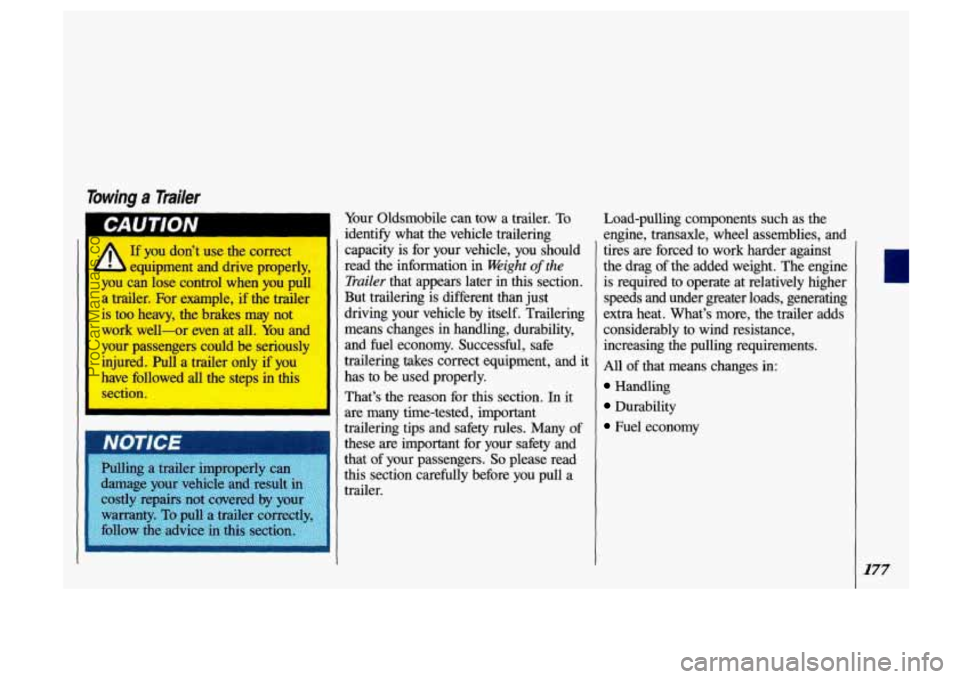
Towing a Tmiler
I I If you don’t use the correct I
L L equipment and drive properly,
you can lose control when you pull
a trailer. For example, if the trailer
is too heavy, the brakes may not
work well-or even at all. You and
your passengers could be seriously
injured. Pull a trailer only
if you
have followed all the steps in this section. Your
Oldsmobile can tow a trailer. To
identify what the vehicle trailering
capacity is for your vehicle, you should
read the information in
Weight of the
Trailer
that appears later in this section.
But trailering
is different than just
driving your vehicle
by itself. Trailering
means changes
in handling, durability,
and fuel economy. Successful, safe
trailering takes correct equipment, and
it
has to be used properly.
That’s the reason for
this section, In it
are many time-tested, important
trailering tips and safety rules. Many of
these are important for your safety and
that of your passengers.
So please read
this section carefully before you pull a
trailer. Load-pulling components such as the
engine, transaxle, wheel assemblies, and
tires
are forced to work harder against
the drag of the added weight. The engine
is required to operate at relatively higher
speeds and under greater loads, generating
extra heat. What’s more, the trailer adds
considerably to wind resistance, increasing the pulling requirements.
All
of that means changes in:
Handling
Durability
Fuel economy
177
ProCarManuals.com
Page 181 of 323
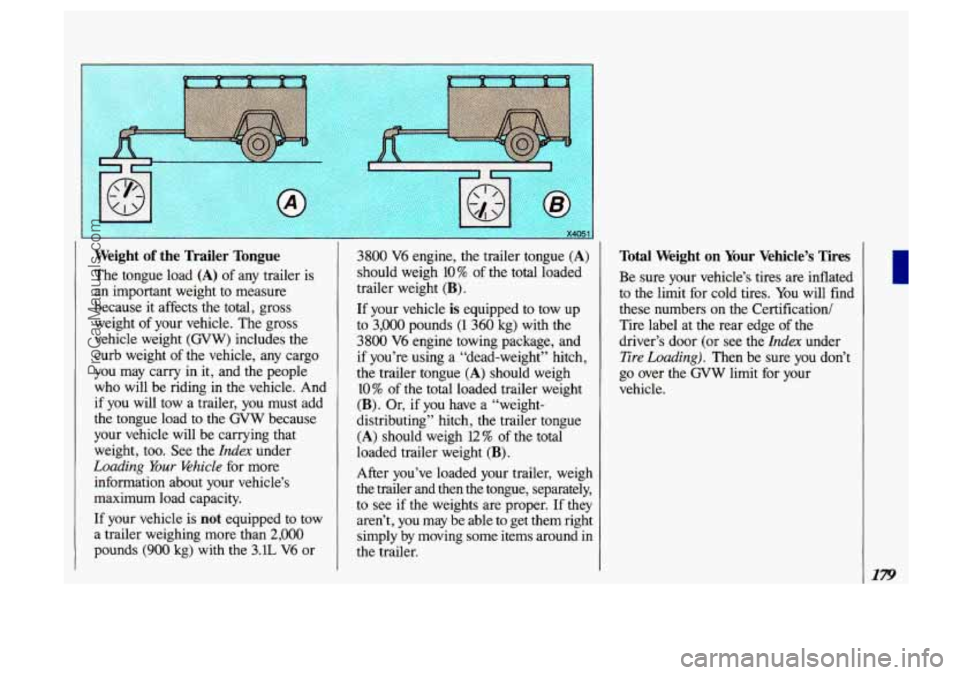
Weight of the Trailer Tongue
The tongue load (A) of any trailer is
an important weight to measure
because it affects the total, gross
weight of your vehicle. The gross
vehicle weight
(GVW) includes the
curb weight of the vehicle, any cargo
you may carry in it, and the people
who will be riding in the vehicle. And
if you will tow a trailer,
you must add
the tongue load
to the GVW because
your vehicle will be carrying that
weight, too.
See the Index under
Loading Your khicle for more
information about your vehicle’s
maximum load capacity.
If your vehicle is not equipped to tow
a trailer weighing more than
2,000
pounds (900 kg) with the 3.1L V6 or
3800 V6 engine, the trailer tongue (A)
should weigh 10% of the total loaded
trailer weight
(B).
If your vehicle is equipped to tow up
to
3,000 pounds (1 360 kg) with the
3800
V6 engine towing package, and
if you’re using a “dead-weight” hitch,
the trailer tongue
(A) should weigh
10% of the total loaded trailer weight
(B). Or, if you have a “weight-
distributing” hitch, the trailer tongue
(A) should weigh 12% of the total
loaded trailer weight
(B).
After you’ve loaded your trailer, weigh
the trailer and then the tongue, separately,
to see if the weights are proper. If they
aren’t, you may be able to get them right
simply by moving some items around in
the trailer.
Total Weight on Your Vehicle’s Tires I
Be sure your vehicle’s tires are inflated
to the limit for cold tires.
You will find
these numbers on the Certification/
Tire label at the rear edge
of the
driver’s door (or see the
Index under
Tire Loading). Then be sure you don’t
go over the GVW limit for your
vehicle.
ProCarManuals.com
Page 247 of 323
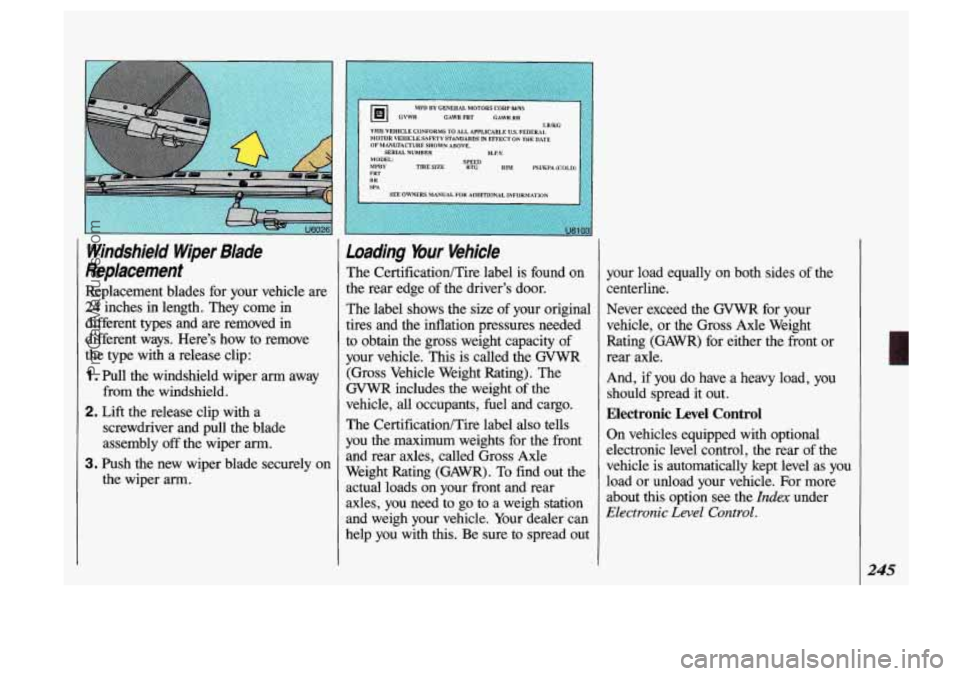
Windshield Wiper Blade
Replacement
Replacement blades for your vehicle are
24 inches in length. They come in
different
types and are removed in
different ways. Here's how to remove
the type with a release clip:
1. Pull the windshield wiper arm away
from the windshield.
2. Lift the release clip with a
screwdriver and pull the blade
assembly
off the wiper arm.
the wiper arm.
3. Push the new wiper blade securely on
CAWRFRT GAWRRR
THIS MH1CX.E CONNJRMS TU ALL APPLICABLE US FEDERAL
OF MANUFACWRE SHOWN ABOVE. MOTOR YWICLE SAFETY SPANDARDS lN EFFECT ON TAe DAn
SERIAL MlMBBR
TIRESIZE '%ED RIM PSYKPA(C0LD)
Loading Mur Vehicle
The CertificatiodTire label is found on
the rear edge of the driver's door.
The label shows the size
of your original
tires and the inflation pressures needed
to obtain the gross weight capacity of
your vehicle. This is called the
GVWR
(Gross Vehicle Weight Rating). The
GVWR includes the weight of the
vehicle,
all occupants, fuel and cargo.
The CertificatiodTire label also tells
you the maximum weights for the front
and rear axles, called Gross Axle
Weight Rating (GAWR). To find out the
actual loads on your front and rear
axles, you need to go to a weigh station
and weigh your vehicle. Your dealer can
help you with this. Be sure to spread out your load equally on both sides
of the
centerline.
Never exceed the
GVWR for your
vehicle, or the Gross Axle Weight
Rating (GAWR) for either the &ont or
rear axle.
And, if you do have a heavy load, you
should spread
it out.
Electronic Level Control
On vehicles equipped with optional
electronic level control, the rear of the
vehicle
is automatically kept level as you
load or unload your vehicle. For more
about
this option see the Index under
Electronic Level Control.
L
245
ProCarManuals.com
Page 254 of 323
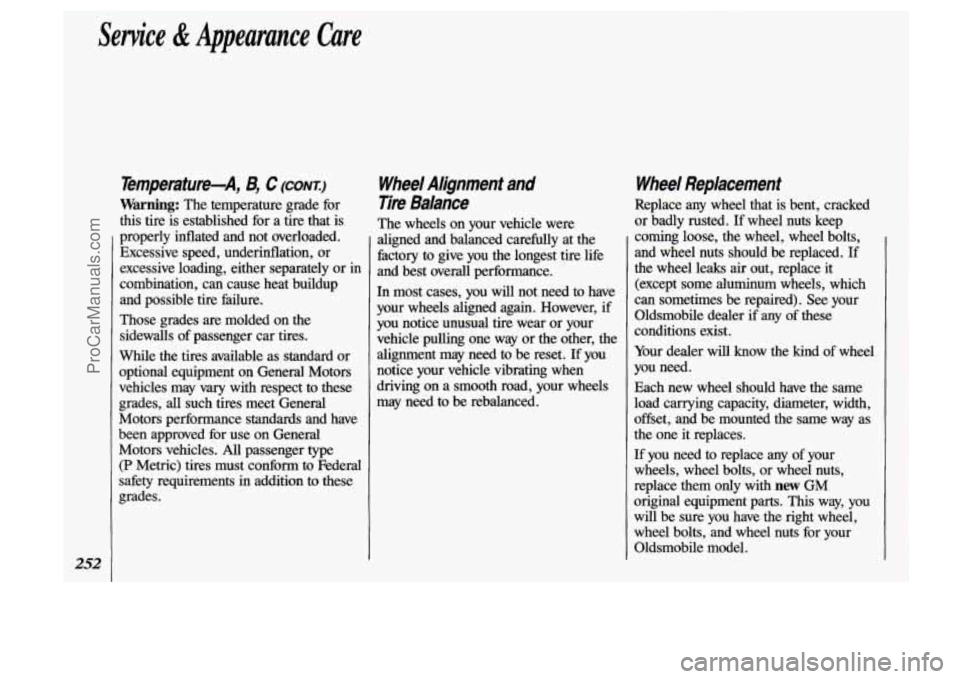
Service & Appearance Care
252
Temperature-A, B, C (CONT)
Warning: The temperature grade for
this tire is established for a tire that is
properly inflated and not overloaded. Excessive speed, underinflation, or
excessive loading, either separately or in
combination, can cause heat buildup
and possible tire failure.
Those grades are molded on the
sidewalls of passenger car tires.
While the tires available as standard or
optional equipment on General Motors
vehicles may vary with respect to these
grades, all such tires meet General
Motors performance standards and have
been approved for use on General Motors vehicles.
All passenger type
(P Metric) tires must conform to Federal
safety requirements in addition to these
grades.
Wheel Alignment and
Tire Balance
The wheels on your vehicle were
aligned and balanced carefully at the
factory to give you the longest tire life
and best overall performance.
In most cases, you will not need to have
your wheels aligned again. However,
if
you notice unusual tire wear or your
vehicle pulling one way or the other, the
alignment may need to be reset. If you
notice your vehicle vibrating when
driving on a smooth road, your wheels
may need to be rebalanced.
Wheel Replacement
Replace any wheel that is bent, cracked
or badly rusted. If wheel nuts keep
coming loose, the wheel, wheel bolts,
and wheel nuts should be replaced. If
the wheel leaks air out, replace it
(except some aluminum wheels, which
can sometimes be repaired). See your
Oldsmobile dealer
if any of these
conditions exist.
Your dealer will know the kind of wheel
you need.
Each new wheel should have the same
load carrying capacity, diameter, width,
offset, and be mounted the same way as
the one it replaces.
If you need
to replace any of your
wheels, wheel bolts, or wheel nuts,
replace them only with
new GM
original equipment parts.
This way, you
will be sure you have the right wheel,
wheel bolts, and wheel nuts for your Oldsmobile model.
ProCarManuals.com